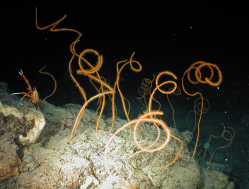MMS Funding Expedition to Study Deepwater Coral Habitats

A joint expedition funded by MMS and NOAA to study the distribution and abundance of deepwater coral habitats in the Gulf of Mexico recently departed from Key West, Florida. This project is conducted under the auspices of the National Oceanographic Partnership Program.
(From MMS)–WASHINGTON – The Interior Department’s Minerals Management Service, in collaboration with the National Oceanic and Atmospheric Administration’s Office of Ocean Exploration and Research, recently launched the third expedition in a four-year, 3.7 million dollar study to learn more about sensitive coral habitats and how to protect them from potential threats.
This project is being conducted under the auspices of the National Oceanographic Partnership Program (NOPP), a collaboration of Federal agencies providing leadership and coordination of national oceanographic research and education programs. NOPP brings the public and private sectors together to support larger, more comprehensive projects, to promote sharing of resources, and to foster community-wide innovative advances in ocean science, technology and education.

The third expedition of the study recently departed from Key West, Florida. This expedition will study coral reefs off the coast of the northern Gulf of Mexico in water more than 1,000 feet deep. This interagency study focuses on the exploration and investigation of deepwater communities that have developed on both natural and artificial hard substrates including platforms and shipwrecks, with emphasis on deepwater coral habitats. The study also has an exploratory component to look at unidentified shipwrecks in very deep Gulf waters.
“MMS will use the discoveries and results of this study to modify existing regulatory policies and help us protect these important habitats from the impacts of oil and gas exploration,” said Liz Birnbaum, Director of MMS. “The results of this study will also enhance the understanding of deepwater coral communities worldwide.”
There are extensive coral habitats that thrive in very deep waters all over the world at depths of thousands of feet. In the past decade, scientists began to realize the extent of deep-water reefs and the vast variety of animals they host. Research has shown the importance of these high-relief deepwater coral habitats, which represent areas with large numbers and diversity of invertebrates and fishes. Numerous areas of structure-forming corals have been discovered in the deep Gulf of Mexico, but little is known about their distribution and rarity. These reefs provide a refuge for fish, sponges, crustaceans and other marine creatures.
The contract for this four-year study was awarded in July 2008 to TDI Brooks International Inc. with a total science budget of 3.7 million dollars. The interdisciplinary team will include scientists from Louisiana State University, Pennsylvania State University, Texas A&M University-Corpus Christi, Temple University, Woods Hole Oceanographic Institution, C&C Technologies, Smithsonian Institution, and Dauphin Island Sea Lab. Leading scientists from around the world will also participate on this cruise, which is the third of four expeditions to the Gulf of Mexico.
Additional information about the study and the expedition can be found on this web site: http://oceanexplorer.noaa.gov/explorations/09lophelia/welcome.html


